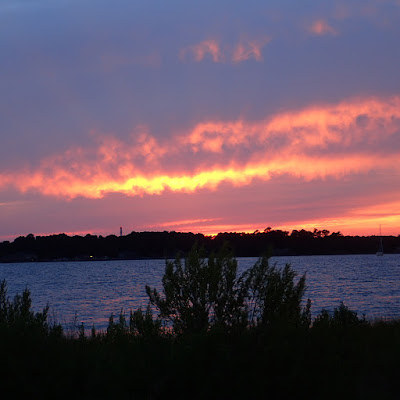I realize that I have gotten off on tangents so now and then, on soap boxes and talked about global warming, training, course development, environmental issues, ecology, stormwater, and even sailing. I should pare down my labels (or subject list), but I guess that's must be my way of showing off. I have made an effort of hiding all the key words (labels) that I've only used once.
Oh well, back the the subject of today's blog: The Northern Neck! (Yes, I wrote about it before in this blog post). The Northern Neck is the northern most peninsula that jots out of the mainland of Virginia. Going from south to north we have: "the Peninsula, where we live; the Middle Peninsula; and the Northern Neck. The Northern Neck has the Potomac River to the north, the Rappahannock River to the south and the Chesapeake Bay to the east.
| View of the Rappahannock River from Belle Isle State Park. |
The Northern Neck is a nice place to visit. It is an hour drive from us on the Peninsula, it is an hour from Richmond, even closer to Fredericksburg and probably an hour to an hour and a half from the greater DC area. It has one of the oldest wineries in Virginia (Ingleside Vineyards) and what I consider one of the best (The Hague Winery, at least three years ago I thought it was one of the best). I reviewed some of the Northern Neck Wineries in this blog post and in a later post (here). It is somewhat out of date. New wineries pop up and I have to visit some of them and revisit some of the old ones; but there are so many in Virginia.
During our visit this past Sunday we saw a sign for the "Good Luck Vineyards", we have not visited it yet, so no review, but we need to go. The name takes me back to the time we spent in Nepal (I worked there in 1981, 82 and 83), and we often stayed in the Good Luck Hotel, so if only for some weird sentimental reason, we should visit this vineyard. If the wineries read this post, they desperately need to invite me to come back to review their wines (hint, hint)! But there is so much more to see. I have not yet visited Reedville, the place made famous by the menhaden, fish oil and the ferry to Tangier Island.
This time it was State Park time. The Northern Neck is host to two State Parks: Westmoreland State Park and Belle Isle State Park. Westmoreland is located on the Potomac and we have stayed in cabins at that park a few years ago. It's a great place. So this time we decided to go hiking at Belle Isle State Park.
| Hiking along the shoreline of the park looking over the Rappahannock |
Belle Isle is on the Rappahannock River. It is relatively new and it is very nice. All the photos in this post were taken at the park. It is worth a day visit. The park also has two cabins that can be rented for overnight stays and a camp ground. I am wondering about sailing there and anchoring out while the rest of the family goes out there and camps or stays in one of the cabins. That would be a riot. However, as you can see from the photos above there is no nice secluded inlet to anchor (my boat draws 4 ft) and you are very exposed there in the middle of the Rappahannock. Yes there is a boat launch, but from what I can see on the charts, the water is only 2 to 3 feet deep and that's not enough for me and my boat. Oh well, so be it, we'll just have to bring the kayaks. There are a lot of kayak opportunities at the park and even canoes for rent.
This Sunday we spent an afternoon hiking some of the trails with the dogs, and just exploring. Belle Isle is relatively new in the state park system and yet has to mature. Never the less it is a nice place to hang out. A great place to walk (it is flat), to kayak/canoe, it has a boat launch, it has a pick-nick area and even a sandy beach. Note that the water is salty. Hopefully the captions on the photos explain things a bit more. Go visit and enjoy.
This Sunday we spent an afternoon hiking some of the trails with the dogs, and just exploring. Belle Isle is relatively new in the state park system and yet has to mature. Never the less it is a nice place to hang out. A great place to walk (it is flat), to kayak/canoe, it has a boat launch, it has a pick-nick area and even a sandy beach. Note that the water is salty. Hopefully the captions on the photos explain things a bit more. Go visit and enjoy.
| A creek that you cross going from the mainland on to the island |
| Another creek crossing going on to the island |
| A view of the Rappahannock from the Island |





















